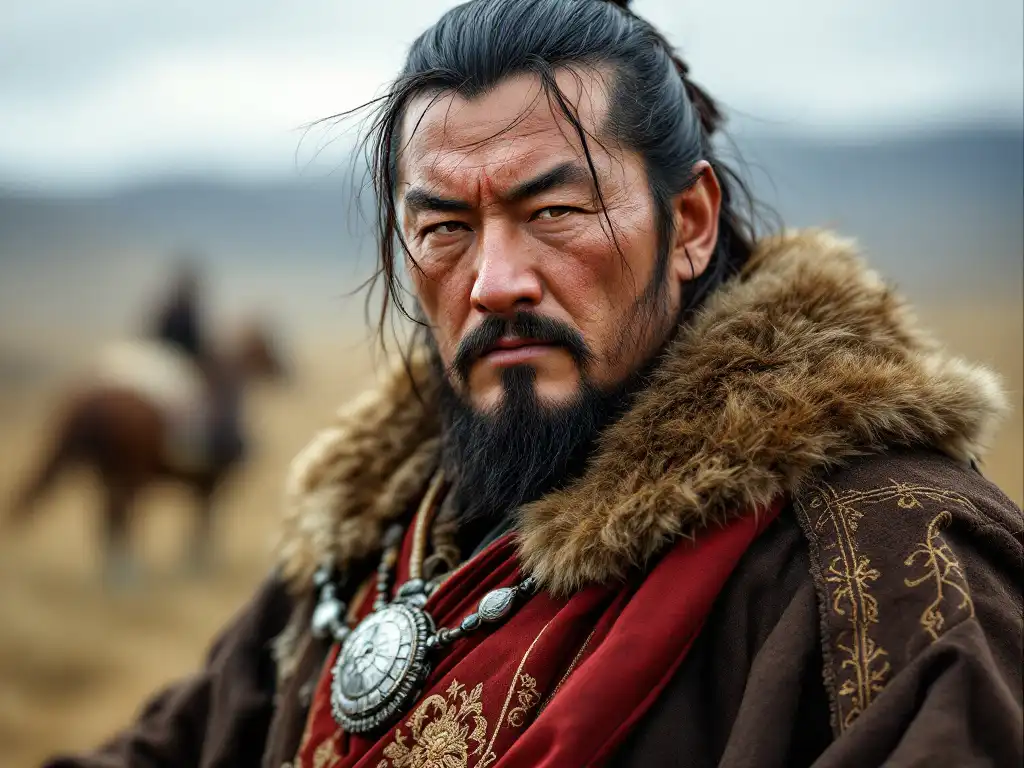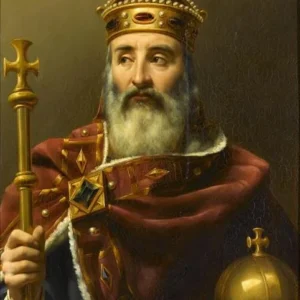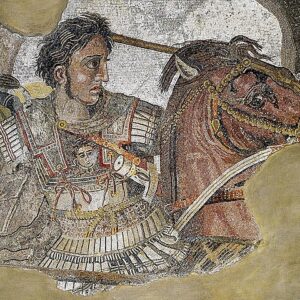Genghis Khan is often remembered as the ultimate warrior, a man who led the largest contiguous empire in history and reshaped the course of civilization. But was he just a ruthless conqueror, or a strategic genius who laid the foundation for modern states?
This article goes beyond the traditional narrative by exploring his leadership psychology, his impact on world history, and how historians have viewed him over time.
Introduction: The Man Who Shaped the World
Who Was Genghis Khan?
Genghis Khan, born Temüjin, was more than just a warlord—he was a visionary leader, ruthless warrior, and master strategist. His ability to unite the fragmented Mongol tribes and transform them into a world-dominating empire set him apart from any conqueror before or after him. His campaigns spanned Asia, the Middle East, and even parts of Europe, bringing destruction but also fostering cultural exchange and innovation.
Why His Legacy Still Matters Today
Despite ruling over 800 years ago, Genghis Khan’s impact is still evident in military strategy, trade, governance, and even genetics. His empire connected the East and West, laying the foundation for globalization, economic expansion, and scientific progress. Without his influence, the Silk Road might never have flourished as it did, and many technological advancements may have taken longer to reach Europe.
A Complex Figure: Hero or Villain?
While Genghis Khan is often seen as a merciless warlord, responsible for the deaths of millions, he was also a brilliant reformer. Under his rule, laws were standardized, religious tolerance was encouraged, and meritocracy was promoted—a stark contrast to many feudal societies of the time. Historians remain divided on whether he was a genocidal tyrant or a revolutionary leader who changed the world.
The Psychology of a Conqueror: What Drove Genghis Khan?
To understand Genghis Khan’s success, we must look beyond his military victories and examine his psychological traits. His rise from an abandoned child to ruler of the Mongols was not a coincidence—it was driven by resilience, vision, and calculated brutality.
Resilience Through Trauma
At age nine, Temüjin’s father was poisoned by a rival clan, leaving his family abandoned by their own people. Forced to survive in the harsh Mongolian wilderness, Temüjin quickly learned that loyalty was conditional and that survival meant adapting to harsh realities. Instead of succumbing to fate, he used his hardships as fuel, developing a determination and toughness that would define his rule.
Unbreakable Vision
From an early age, Temüjin recognized that the Mongol tribes were too divided to stand against powerful enemies like the Jin Dynasty of China. Unlike other tribal leaders who focused on short-term power, Temüjin saw a bigger picture—a unified Mongol nation that could dominate the world stage. His ability to convince warriors to fight for a cause bigger than themselves was one of his greatest strengths.
Calculated Brutality
Unlike other rulers who acted out of sheer cruelty, Genghis Khan used violence as a tool. He understood that fear could be a powerful weapon. Cities that resisted Mongol rule were often razed to the ground, while those who surrendered were spared and integrated into the empire. This approach minimized resistance in future conquests, allowing his army to expand rapidly with minimal losses.
Early Life: From Outcast to Leader
Birth and Name: The Origins of Temüjin
Born around 1162, near the Onon River, Temüjin’s name symbolized strength and endurance—qualities that would define his reign. Unlike the sons of noble Mongol leaders, who often inherited power, Temüjin had to fight for everything.
The Assassination of His Father and Family’s Exile
Temüjin’s father, Yesügei, was poisoned by a rival clan when Temüjin was still a child. Without his father’s protection, his family was cast out by their own people, forced to live in extreme poverty. These early struggles hardened Temüjin, teaching him that trust was rare, and power was everything.
Surviving as an Outcast
Alongside his mother and siblings, Temüjin lived off the land, hunting small animals and foraging for food. His mother, Hoelun, played a crucial role in his survival, teaching him that strength and intelligence were more valuable than noble birth.
Escape from Captivity and First Signs of Leadership
As a teenager, Temüjin was captured and enslaved by a rival Mongol tribe, the Tayichiud. He escaped by killing his captor, proving his resourcefulness, courage, and ability to inspire followers. His escape marked the first step toward his rise as a leader, as loyal warriors began to rally behind him.
The Rise to Power: Uniting the Mongol Tribes
The Importance of Alliances
Recognizing that military strength alone wasn’t enough, Temüjin focused on building strong alliances. He was a master of diplomacy, securing loyalty through marriage, political negotiations, and military victories.
Marriage to Börte: Love and Strategy
His marriage to Börte, a woman from the Onggirat tribe, was both a personal and political move.
- Börte’s kidnapping by the Merkit tribe prompted Temüjin to launch his first major military campaign.
- With the help of Toghrul, the leader of the Kerait tribe, Temüjin successfully rescued her.
- This act proved his military capability and earned him loyal followers.
Defeating the Tatars: A Campaign of Vengeance
Temüjin never forgot his father’s murder and sought revenge against the Tatars.
- Instead of traditional Mongol tribal warfare, he introduced organized, strategic battles.
- After multiple campaigns, the Tatars were crushed, and their leaders executed.
- He implemented a policy of absorbing skilled survivors into his growing army rather than slaughtering them.
The Rivalry with Jamukha
Jamukha, a former childhood friend, became Temüjin’s most significant rival.
- Unlike Temüjin, Jamukha favored the old tribal aristocracy.
- Their forces clashed, and after a series of brutal battles, Temüjin emerged victorious.
- His decisive victory over Jamukha solidified his dominance over Mongolia.
1206 Kurultai: The Birth of Genghis Khan
In 1206, Mongol leaders declared him “Genghis Khan” (“Universal Ruler”), marking the official foundation of the Mongol Empire.
The Mongol War Machine: Strategies and Innovations
The Mongol army was unlike any military force the world had ever seen. It wasn’t just the sheer number of Mongol warriors that made them unstoppable—it was their tactics, training, discipline, and ability to adapt that enabled them to crush far larger and more technologically advanced armies.
What Made the Mongol Army Unstoppable?
Superior Horseback Archery
Mongol warriors were trained from childhood to shoot arrows with deadly accuracy while riding at full gallop. Their composite bows—made of wood, horn, and sinew—were smaller but more powerful than European longbows, allowing them to shoot accurately over long distances.
Mastery of Speed and Mobility
Unlike heavy, slow-moving European armies, Mongol soldiers each had multiple horses and could travel up to 100 miles per day. This allowed them to outmaneuver enemies, launch surprise attacks, and quickly retreat if needed.
Feigned Retreats and Psychological Warfare
Genghis Khan perfected the art of deception. His army would pretend to flee in panic, only to turn around and ambush pursuing enemies. This tactic worked time and again, leading to some of his greatest victories.
The Mongols also spread terror intentionally. They would completely annihilate cities that resisted, ensuring that the next city would surrender without a fight. Stories of Mongol brutality traveled ahead of their army, often causing entire regions to submit without resistance.
Strict Military Discipline and Merit-Based Promotions
Unlike feudal European armies where rank was based on birth, Genghis Khan rewarded skill, loyalty, and bravery over noble lineage. This created an army that was highly motivated and fiercely loyal to their leader.
The Use of Intelligence and Spies
The Mongols had a sophisticated espionage network. Before attacking, they would send spies disguised as merchants into enemy cities to gather intelligence. They knew their enemies’ weaknesses, terrain, and political conflicts before launching an attack.
The Conquest of China: Breaking the Great Wall
The Jin Dynasty: A Formidable Opponent
In 1211, Genghis Khan turned his attention to China, where the Jin Dynasty ruled northern China. The Jin were far richer and more powerful than the Mongols, with fortified cities and vast armies. However, their defenses relied heavily on stationary fortifications, which the Mongols outmaneuvered with their mobile cavalry.
Adapting to Siege Warfare
Initially, the Mongols had no experience with sieging walled cities. But Genghis Khan, always a quick learner, captured Chinese and Persian engineers, forcing them to build catapults, battering rams, and siege towers.
The Fall of Zhongdu (Beijing)
By 1215, the Mongols had besieged and captured Zhongdu (modern-day Beijing). The city was burned to the ground, and its rulers executed. The Mongols then turned northwest, ready to take on a new enemy—the Khwarezmian Empire of Persia.
The Destruction of the Khwarezmian Empire
A Fatal Diplomatic Mistake
In 1218, Genghis Khan sent a diplomatic mission to Shah Ala ad-Din Muhammad of the Khwarezmian Empire (modern-day Iran, Turkmenistan, and Uzbekistan). The Mongols wanted peaceful trade relations, but the Shah made a grave mistake—he executed Genghis Khan’s ambassadors.
For Genghis Khan, this was an unforgivable insult. His response was swift and merciless: he unleashed his entire army on the Khwarezmian Empire.
The Siege of Samarkand
In 1220, the Mongols stormed the city of Samarkand, slaughtering thousands of people and burning the city to the ground.
The Mongols used brilliant military strategies, such as:
- Dividing the army to launch simultaneous attacks on multiple cities, preventing reinforcements.
- Flooding enemy cities with prisoners of war, forcing them to defend against their own captured soldiers.
- Destroying irrigation systems, turning fertile lands into deserts.
Within two years, the Khwarezmian Empire ceased to exist. The Shah fled into exile, only to die in obscurity on a remote island.
The Mongol Invasion of Europe
By 1223, Mongol generals Subotai and Jebe had already defeated a coalition of Russian princes at the Battle of Kalka River. This was Russia’s first encounter with the Mongols, and it ended in total destruction. The Mongols then raided Poland and Hungary, proving that even Europe was not safe from Mongol expansion.
Why the Mongols Stopped Their Invasion of Europe
Just as the Mongols were preparing to invade Western Europe, Genghis Khan died in 1227, and the Mongols withdrew to elect a new Great Khan. Europe was spared—not because of military strength, but due to timing.
The Mongol Empire’s Impact on the World
The Pax Mongolica: A Golden Age of Trade
Under Mongol rule, the Silk Road flourished like never before. Trade between Europe, the Middle East, and China became faster, safer, and more profitable. The Mongols protected merchants, standardizing weights, measures, and currency across their empire.
The Spread of Technology and Ideas
The Mongols spread gunpowder, paper money, printing technology, and advanced postal systems across Eurasia. This helped spark the European Renaissance.
The Dark Side: The Black Death
Unfortunately, Mongol trade routes also helped spread the bubonic plague to Europe, leading to the Black Death, which killed one-third of Europe’s population.
Conclusion: The Enduring Impact of Genghis Khan
Genghis Khan wasn’t just a conqueror—he was a revolutionary force in world history. He united the Mongol tribes, created a highly efficient military machine, and shaped global trade and culture in ways that still resonate today.
His legacy remains controversial:
- To some, he was a genocidal warlord who killed millions.
- To others, he was a visionary leader who transformed the world.
Regardless of perspective, one thing is certain: Genghis Khan changed the course of history forever.
FAQs: Quick Answers to Common Questions
What does “Genghis Khan” mean?
“Universal Ruler.”
How did Genghis Khan die?
Likely from battle wounds, illness, or a fall from his horse.
What was the size of his empire?
Over 24 million square kilometers—the largest contiguous land empire in history.
Did Genghis Khan really kill millions?
Yes, but his conquests also unified vast regions and advanced global trade.
Are there living descendants today?
Yes! Genetic studies suggest 16 million men carry his DNA.



